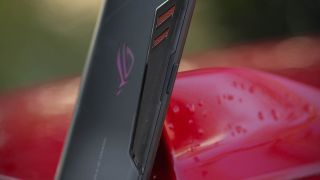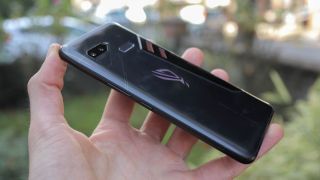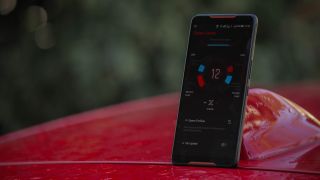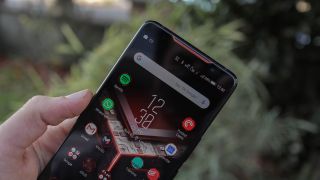Why you can trust TechRadar
Design
- Metal frame and accents
- Gorilla Glass 6 protection
- Bold, gamer-centric styling
When we got this phone in our hands, the first thing we thought was - this thing looks angry and feels bold. That’s because the metal frame is cold, stark and sports heavy bevels, creating a first impression that even the rounded corners can’t soften – but this is a gaming phone, and that’s kind of the point, isn’t it?
Curved Gorilla Glass 6 protection smoothly envelopes the back of the Asus ROG Phone, underneath which sit sci-fi-esque glyphs, along with the illuminating ROG logo. A prominent metal accent interrupts the curved glass, complete with bronze metal grilles, only adding to the phone’s grrrr appeal.
After a week of using the phone, the glass hadn’t picked up any scratches which is reassuring. The black metal frame and accent, however, did pick up a few scuffs, and unfortunately those scuffs revealed a starkly contrasting silver – not a deal-breaker, but definitely worth noting if you’re on the fence about picking up a case for your ROG Phone.

The asymmetrical hexagonally shaped camera surround and fingerprint scanner are both off center, with the camera slightly to the left and the fingerprint scanner to the right. Despite this, Asus has managed to keep things in intuitive positions, so a fumbling finger will land on the scanner without any issues.
On the phone’s front is a set of speakers up top and bottom, a 6-inch Full HD+ AMOLED display sandwiched in between them, and, at the top, an 8MP front camera.
With 76.8% of the phone’s front being screen it hasn’t got the biggest bezels in town, but it definitely can’t compete with the more edge-to-edge screened phones out there, like the Oppo Find X with its 87% screen-to-body ratio, and the OnePlus 6T at 86%.

There’s a healthy selection of ports dotted across the ROG Phone’s frame – one USB-C port and a headphone jack at the bottom and to the left, and another USB-C port on the left side for charging while gaming in landscape mode and for accessory docking.
The biggest oversight when it comes to the design of the ROG Phone is the rubber stopper that plugs the side-mounted USB-C port. It’s impossible to remove if you have short nails, and it’s small and completely detaches from the phone, so is likely to get lost.
Volume and power buttons are on the right, and the whole frame doubles up as a button of sorts, thanks to squeeze input, as found on the Google Pixel 3. Squeeze the bottom third of the handset firmly and you can activate an app or feature, with short-squeeze and long-squeeze commands programmable.

By default, this squeeze command is set to fire up X Mode, lighting up the RGB logo on the back of the phone, clearing background processes and powering up the look of the UI with some red accents and a cool wallpaper animation.
Aside from its fiddly port cover though, the design of the ROG Phone gets a thumbs-up from us – much to our surprise. We heard “That’s ridiculous!” at least as many times as we heard “That’s so cool!” from onlookers – but while it’s divisive it’s also bold, and by the end of the week we were defending it; it’s one of the first gadgets we’ve used in ages that combines utility with a fun, indulgent user experience.
Display
A 6-inch Samsung AMOLED screen is matched with HDR credentials, Full HD+ resolution and a 90Hz refresh rate to deliver a really satisfying user experience.
On paper it loses out to the Razer Phone 2 by packing fewer pixels and a lower refresh rate, although while both these comparative shortcomings are noticed, especially when using the two phones side-by-side, they weren’t really issues.
If you aren’t sure what a refresh rate is, in a nutshell it’s the number of times a screen image refreshes in a second, with 60Hz being the average for a smartphone – so the image refreshes 60 times every second.
If you’re playing a 60 frames per second game on a 60Hz screen, each frame will show a slightly different image, double the number of images a 30Hz screen would display in the same amount of time. The higher the refresh rate, the smoother the content will look, provided your game or video is optimized to take advantage of the screen’s high refresh rate.
The 90Hz ROG Phone screen therefore looks smoother than most 60Hz screen, while at 120Hz the Razer Phone 2’s refresh rate is the smoothest of the bunch, putting it on a par with many gaming monitors, although those can go up to 240Hz.

The refresh rate is actually set to 60Hz by default, and you can change it to 90Hz in the settings, either permanently or on a game by game basis. At 90Hz the display does look beautifully smooth, noticeably more so than other smartphones – other than the Razer Phones, of course.
It also looks less sharp than the Razer Phone 2, with the 1080 x 2160 Full HD+ screen clocking in at 402 pixels per inch, compared to Razer’s 513ppi flagship. This is compounded by the AMOLED tech inside, which has pixels that are a bit less sharp than LCD pixels thanks to their sub-pixel formation.
You can only clearly see this when you’re looking through a magnifying glass or at a close-up photo – see the close-up photo below – but the real-world effect is a slightly softer screen, especially when displaying small text.

Despite this, the ROG Phone’s AMOLED tech delivers so much more punch than the Razer Phone 2’s IGZO display, not to mention significantly better viewing angles. The longer 18:9 aspect ratio means that despite its 6-inch size, the ROG Phone is also more comfortable to hold than Razer’s 5.72-inch flagship.
It’s also worth noting that apps like Instagram are starting to prioritize support for longer-aspect-ratio devices like the ROG Phone, with the trend going that way in the iPhone ecosystem too – so if you have a Razer Phone 2 there’s a good chance you’ll see cropped Instagram stories every now and then:

So while on paper the Asus ROG Phone loses out to Razer’s latest flagship in many respects, in reality we’d take a 90Hz, 18:9, light-on-bezels AMOLED display against a 120Hz, 16:9, bezel-heavy IPS screen any day of the week.
Basil Kronfli is the Head of content at Make Honey and freelance technology journalist. He is an experienced writer and producer and is skilled in video production, and runs the technology YouTube channel TechEdit.


